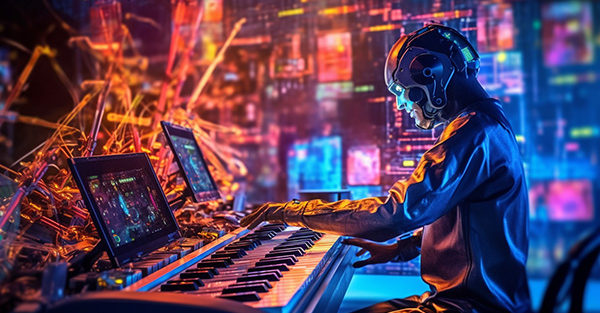In the midst of a personal struggle, I found solace in a creative refuge: composing music that mirrored the kaleidoscope of my emotions.
Those compositions remained dormant, a collection of 12 tracks waiting for their moment to shine. Little did I know that their journey would lead them through a changing landscape, one significantly altered by the disruptive power of Artificial Intelligence (AI).
This narrative is not unique. Countless musicians have walked similar paths, nurturing melodies, penning lyrics, and crafting harmonies, only to witness their creations remain unheard by the world. Traditionally, sharing music was confined to live performances, distributing homemade CDs to a small circle of friends, or the daunting process of courting record labels—a process fraught with challenges and risks.
Yet, this narrative has transformed. Today, while physical formats like CDs and vinyl continue to find favor among music enthusiasts, streaming services have ascended to the forefront, reshaping the music consumption landscape. The barriers that once stood tall, guarded by record label gatekeepers, have been lowered. Welcome to the golden era of independent music, where the reins of album launches are no longer held by mainstream authorities. Instead, they are in the hands of the creators.
The catalyst behind this democratization of music distribution lies in the evolution of digital music distributors. No longer is an artist’s vision and work bound to the approval of an A&R executive. The arduous task of securing a record deal has been replaced by the ability to independently release music across platforms such as Spotify, Apple Music, Amazon Music, iTunes, Deezer, Tidal, and beyond.
I embarked on this new-age musical journey, harnessing the power of AI to complement my artistic endeavors. Let’s delve into the pivotal role AI played in this transformation.
AI’s Artful Contribution:
While AI’s fingers did not pluck strings or strike keys to compose, mix, or master my music, it did lend a creative hand in other aspects:
1. Album Cover Art: An AI-assisted creation breathed life into the visual identity of my music, a portal into the emotions the melodies encapsulated.
2. Music Genre Identification: Leveraging AI’s ability to discern musical patterns, my compositions found their genre classification, bridging the gap between my sound and listeners seeking similar vibrations.
3. Promotional Prose: Descriptions of my music, written with AI’s assistance, conveyed the essence of each track, allowing listeners to dive into the soul of the melodies.
4. Artist Identity: Crafting an artist bio, shaping my image, and extending banners on websites, AI was a collaborator in shaping the narrative around my music.
AI as a Creative Catalyst, Not Composer:
It’s crucial to clarify that AI did not compose, mix, or birth the music itself. My compositions are an extension of my emotions, my skills, my journey. While AI’s involvement enriched the peripheral aspects, the core of the music emanates from the depths of my heart and soul.
The symphony of my transformation underscores the profound impact AI has on the music industry. As creators, we stand at the crossroads of tradition and innovation, harmonizing our unique expressions with AI’s amplifying capabilities. With the reins in our hands and AI as our ally, we navigate an era where melodies know no bounds, and stories are shared without gatekeepers.
In a world where notes traverse digital landscapes and AI fuels artistic narratives, the sound of change is unmistakable, inviting all musicians to join the orchestra of transformation.



